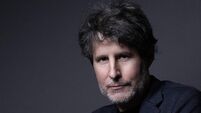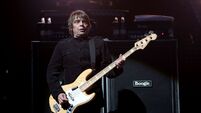Book review: Familiar names in colourful, gritty romp across 1980s New York

Donald Trump, in 1987, flying aboard his Puma helicopter from New York City to Atlantic City, crops up in 'The Gods of New York' in all his technicolour glory.
- The Gods of New York: The Tumultuous Eighties, from Donald Trump to the Tompkins Square Riots
- Jonathan Mahler
- Hutchinson Heinemann, €29.00
Early on in , Jonathan Mahler’s enthralling overview of the city in the second half of the 1980s, he paints a flattering portrait of a zealous, diligent, and innovative district attorney who goes after mobsters, corrupt politicos, and dodgy Wall Street types.
A crusader for justice wearing a suit instead of a cape, this brilliant lawyer went by the name of Rudy Guiliani.
Imagine. Once upon a time, the sad sack ghoulish knave who so debased himself and his reputation, hair dye dripping down his face, Four Seasons Landscaping and all that, was once a serious prospect.
Deadly serious. And, mostly, a force for good trying to improve the lives of his fellow citizens.
A work of recent history like this benefits and suffers from the fact we know many of the dramatis personae because they remain in the public eye.
And Mahler succinctly sums up the cast list of rogues with the evocative subtitle, “Egotists, Idealists, Opportunists, and the Birth of the Modern City, 1986-90”.
Dr Anthony Fauci is an obvious one whose status is in the eye of the beholder.
The physician is the butt of so many conspiracy theories around covid that he requires constant armed protection these days.
Back then, he was a pioneering epidemiologist in on the ground floor of the fight to figure out a way to stop young men in the city dying from Aids.
He was getting regularly lambasted then too by Larry Kramer, the gay rights campaigner, for not moving fast enough.
Fauci’s defence was simple — real scientific progress takes time. Later, in a move that sums up what a quality person he is, he ended up becoming Kramer’s GP.
Much less noble is the story of Reverend Al Sharpton who came to national prominence in that decade because so many New York stories garnered national attention.
At his best, he was in the vanguard of the fight for social justice. At his worst, he was a charlatan profiting from racial tension, propagating falsehoods that ruined lives, and, somewhere in between, serving as an FBI informant.

To get him to pass on incriminating information about the boxing promoter Don King, the feds first caught him in a sting when he turned up at an apartment of theirs to purchase cocaine.
As with everybody who looms large in this tale, Mahler doesn’t spare Sharpton, now a respectable cable news host, for his part in that debacle or his shameful role in the Tawana Brawley rape hoax.
This brutal disregard for reputations is what makes his book a compelling portrait of a city convulsed by racial tension, beset by political grifters.
At a remove of nearly four decades, the astonishing thing is how little has changed in terms of New York being a place as roiled by the same malevolent forces now as it was then.
Mahler diligently chronicles a mayoral election eerily similar in tone and tenor to the one that recently played out here.
The eighties edition featured a past-it incumbent trying to hold on to power as a gaggle of chancers sought to manipulate the racial tension, the crime and homelessness statistics to their own political ends. Plus ca change.
More than one commentator in America has likened this fine work to Tom Wolfe’s , the epic novel covering the same era in the city’s history.
Heady praise. It’s not quite that good but it’s a fast-paced, gritty, colourful, and entertaining romp through a fascinating period.
BOOKS & MORE
Check out our Books Hub where you will find the latest news, reviews, features, opinions and analysis on all things books from the Irish Examiner's team of specialist writers, columnists and contributors.







